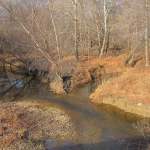
PTRC has been working for several years with the State of Maryland, Charles County, the Town of La Plata, the Chesapeake Bay Trust (CBT), and many local partners to implement protection and restoration projects identified in the Port Tobacco River Watershed Restoration Action Strategy
PTRC’s advocacy for restoration of a wetland along a 2,800 foot section of Port Tobacco Creek has resulted in the award of $70,000 in grants to for the mapping, permitting, and engineering work to support construction of the wetland.
In partnership with CBT, Maryland Department of Natural Resources, and the property owner, PTRC obtained a grant to direct run-off water from Hawthorne Golf Course to a constructed wetland, which filters nitrogen, phosphorous, and sediment that were once carried directly into the Port Tobacco Creek.
PTRC worked with Charles County Public Schools and a CBT grant to design and construct three rain gardens at McDonough High School that filter runoff water from 61,020 square feet of parking lots and other impervious cover. Students from the McDonough High School and the Stethem Educational Center helped plant the gardens.
Through a Charles County Forestry Grant, and with the help of Charles County Schools students and local Boy Scouts, PTRC planted over 10,000 trees to create fifty-foot riparian buffers in a wetland mitigation area along eroded banks of the Port Tobacco Creek near the intersection of Hawthorne and Mitchell Roads.

PTRC partnered with the CBT and six local partners in the construction of a demonstration storm water management project in the parking lot of the La Plata Commerce Center off US 301. The facility slows and cleans polluted storm water runoff before it reaches pipes that carry it directly into the Port Tobacco River.
Fencing to exclude livestock protects a stream bank on Port Tobacco Creek due to a partnership among PTRC, a local farmer and the Charles County Soil Conservation District. The project also included installation of a well and trough to provide an alternative source of water for the cattle.
Dozens of dedicated PTRC volunteers have mobilized for cleanups at Chapel Point State Park, removing trash that would otherwise interfere with public enjoyment of the park and create entanglement hazards for wildlife.
While much remains to be done, new requirements at the state and local level for cleaning up the Chesapeake Bay bring with them new sources of funding for restoration projects and new opportunities for achieving our goal of protecting and restoring the Port Tobacco River and its watershed.
The Charles County Phase II Watershed Implementation Plan (WIP) describes the county’s strategy for meeting its share of Bay pollution reduction goals. The WIP recognizes the need to reduce pollution from septic systems, an issue that is critical to the health of the Port Tobacco River.
In addition, both the WIP and the County’s Municipal Separate Storm Sewer (MS4) discharge permit highlight the need for the type of stormwater management projects PTRC has successfully accomplished in the Port Tobacco watershed, such as stream restoration, shoreline stabilization, and buffer plantings.





